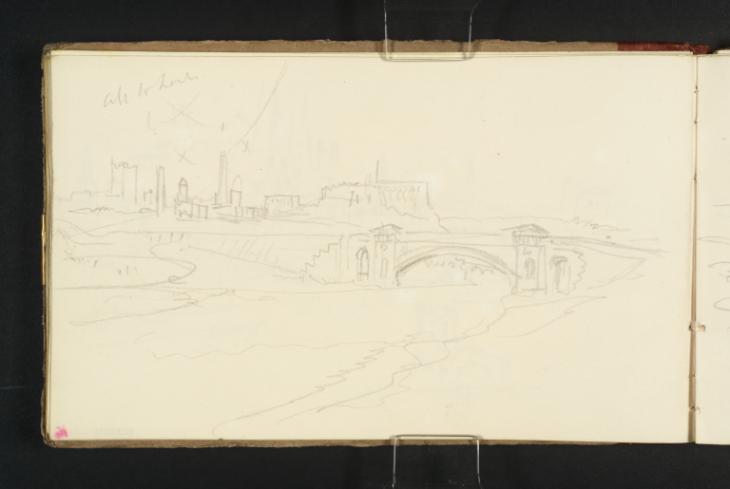Joseph Mallord William Turner Grosvenor Bridge on the River Dee, with Chester Castle Beyond ?1831
Image 1 of 2
Joseph Mallord William Turner,
Grosvenor Bridge on the River Dee, with Chester Castle Beyond
?1831
Joseph Mallord William Turner 1775–1851
Folio 14 Verso:
Grosvenor Bridge on the River Dee, with Chester Castle Beyond ?1831
D22176
Turner Bequest CCXXXIX 14a
Turner Bequest CCXXXIX 14a
Pencil on white wove paper, 114 x 191 mm
Inscribed by Turner in pencil ‘All to [?Low]’ with three ‘x’ marks, top left
Inscribed by Turner in pencil ‘All to [?Low]’ with three ‘x’ marks, top left
Accepted by the nation as part of the Turner Bequest 1856
References
1909
A.J. Finberg, A Complete Inventory of the Drawings of the Turner Bequest, London 1909, vol.II, p.734, CCXXXIX 14a (as ‘Do.’, i.e. ditto; ‘View of Shrewsbury’, as for folio 13 verso D22174).
In undated manuscript notes, A.J. Finberg (died 1939) changed his incorrect 1909 Turner Bequest Inventory identification of this subject from Shrewsbury to ‘Chester’, as did the watercolour and Turner scholar C.F. Bell (died 1966).1 As Ian Warrell has noted, the subject is Grosvenor Bridge over the River Dee in the middle distance, looking north-east2 to the city beyond, seen from the vicinity of what is now Curzon Park North, a residential street backing onto the river opposite the racecourse.
On the skyline above the bridge is Chester Castle, apparently with the tower of St Michael’s Church to the left. The drawing appears slightly confused at this point, with strokes running diagonally across the top left corner with associated ‘x’ symbols and a note possibly indicating that the buildings are all shown ‘to[o] Low’ (or perhaps ‘high’). There is a similar prospect at the top of folio 15 recto opposite (D22177).
Chester, the county town of Cheshire, stands on the River Dee not far from the Welsh border, about thirty miles north of Shrewsbury (see under folio 12 verso; D22172) and south of Liverpool and Manchester (see under folio 12 recto; D22171). Turner had first visited the city in 1794, when he ventured into North Wales for the first time. He drew the castle and cathedral (Tate D40041; verso of Turner Bequest XXI L), and two views of picturesque old houses and shops in the centre (Ashmolean Museum, Oxford). The castle subject was the basis of an untraced watercolour3 engraved in 1796 as Chester (Tate impression: T05892). In 1801 he returned and made studies in and around the city in the Chester sketchbook (Tate; Turner Bequest LXXXII): Tate D05129 (Turner Bequest LXXXII 52) was the source of an untraced watercolour4 engraved in 1810 as Distant View of Chester (Tate impression: T05730); and Tate D05128 (Turner Bequest LXXXII 51) was used for a watercolour of a nearer view of the castle (Ashmolean Museum)5 engraved in the same year as Part of Chester Castle (Tate impression: T05948).
Turner repeated some of these views in the present sketchbook, as cross-referenced under individual entries. One major change in the meantime would have been the completion of the long transformation of Chester Castle from its dilapidated medieval form into a complex of neo-classical civic buildings; see under folio 64 recto (D22269). Another was the construction of the nearby single-arched Grosvenor Bridge over the Dee south-west of the castle, to relieve the Old Dee Bridge. The new structure was designed by Thomas Harrison (1724–1829), who also responsible for the castle buildings. The foundation stone had been laid in 1827, and the bridge was formally opened by Princess (later Queen) Victoria in October 1832, albeit not finally completed and open to traffic until November 1833. It was then the largest single-span stone arch in the world, at some 200 feet across with a vertical clearance of 60 feet (60 by 18 metres).6 Turner’s various views among those noted below, including those on folio 15 recto opposite (D22177), show the bridge in an advanced but incomplete state.
There are other Chester sketches on folios 15 recto and verso, 35 recto, 36 recto, 47 recto, 58 verso–59 recto, 60 recto and verso, 61 recto, 61 verso–62 recto, 62 verso, 63 recto, 63 verso–64 recto, 64 verso, 65 recto and verso and 67 recto (D22177, D22178, D22214, D22216, D22237, D22258–D22272, D22274), and also on folios 70 recto and 81 recto (D22277, D22299; Turner Bequest CCXXXIX 69, 80); unusually for such an extensive sequence of English views, Finberg did not recognise any of them in his 1909 Turner Bequest Inventory, and suggested incorrect identifications for a few,7 as noted in individual entries.
Matthew Imms
April 2014
A.J. Finberg, undated MS notes in a copy of Finberg 1909, Tate Britain Prints and Drawings Room, vol.II, p.734; C.F. Bell, undated MS notes in another copy at the same location, vol.II, p.734.
See Steve Howe, ’12. The Grosvenor Bridge and Overleigh Cemetery’, Chester: A Virtual Stroll around the Walls, accessed 15 April 2014, http://www.chesterwalls.info/grosvenor.bridge .
How to cite
Matthew Imms, ‘Grosvenor Bridge on the River Dee, with Chester Castle Beyond ?1831 by Joseph Mallord William Turner’, catalogue entry, April 2014, in David Blayney Brown (ed.), J.M.W. Turner: Sketchbooks, Drawings and Watercolours, Tate Research Publication, September 2014, https://www


